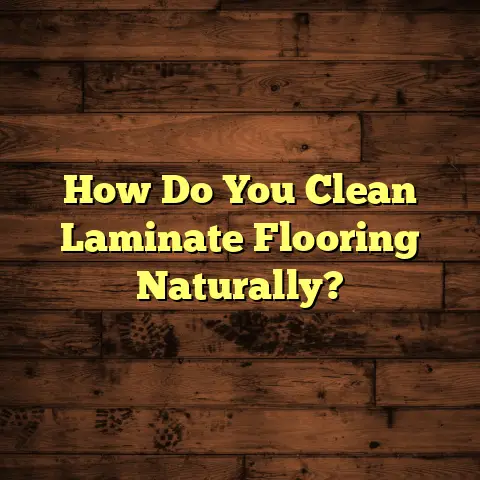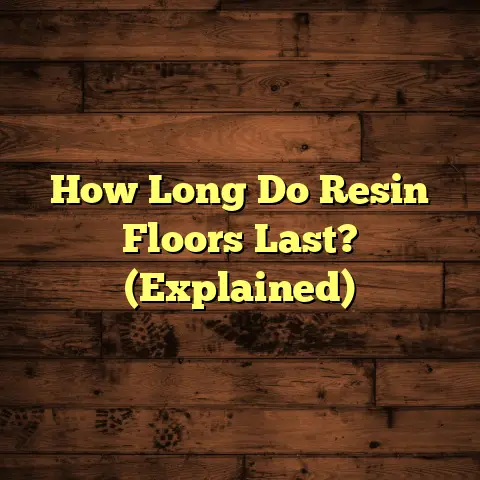Paint Concrete Patio Floors? (7 Ideas Now!)
They’re like that classic pair of jeans – always in style, super versatile, and ready for anything. But let’s be honest, sometimes that plain concrete can feel a little…blah.
That’s where paint comes in! I’m here to tell you why painting your concrete patio floor is a fantastic idea. It’s not just about making it look pretty (though that’s a big part of it!). It’s about protecting your investment, boosting your home’s value, and creating an outdoor space you’ll love to spend time in.
Section 1: The Benefits of Painting Concrete Patio Floors
So, why should you grab a brush and start painting? Here’s the lowdown:
Durability and Longevity
Think of paint as a shield for your concrete. It protects against:
-
Wear and tear: Foot traffic, furniture, and kids playing can really take a toll.
-
Weather elements: Rain, sun, snow – concrete takes a beating.
-
Stains: Spilled drinks, greasy food, and plant debris can leave unsightly marks.
I’ve seen painted concrete patios last for 5-10 years with proper care. Unpainted? They can start showing their age much sooner.
Cost-Effectiveness
Let’s talk money. Replacing a patio with wood or tile can cost thousands. Painting?
A few hundred bucks, tops. According to HomeAdvisor, the average cost to install a concrete patio is between $1,440 and $4,320. Painting? The average cost is between $2 to $6 per square foot.
That’s a huge difference! Plus, you can DIY it and save even more.
Customization and Style
This is where the fun begins! Paint lets you unleash your inner designer.
Want a sleek, modern look? Go for a solid color. Feeling bold? Try a geometric pattern or a vibrant mural.
I’ve helped homeowners create patios that perfectly match their homes and personalities. The possibilities are endless!
Easy Maintenance
Cleaning a painted concrete patio is a breeze. A quick sweep and a hose down are usually all it takes.
Compare that to scrubbing stains out of bare concrete – no fun! Plus, a sealed painted surface resists dirt and grime, making your life easier.
Section 2: Preparing Your Concrete Patio for Painting
Okay, you’re sold on the idea of painting. But hold on! Prep work is key to a long-lasting, beautiful finish.
Assessing the Surface
First, take a good look at your patio. Are there:
-
Cracks? Big or small, they need to be addressed.
-
Chips? These can create unevenness.
-
Stains? You’ll need to remove them before painting.
-
Efflorescence? That’s the white, powdery stuff that can appear on concrete. It needs to be cleaned off.
I always tell my clients that a good inspection is half the battle.
Cleaning the Surface
Time to get your hands dirty! Here’s my go-to cleaning process:
- Sweep: Remove all loose debris.
- Scrub: Use a stiff brush and a concrete cleaner (I like TSP – trisodium phosphate – for tough stains).
- Rinse: Thoroughly rinse with a hose.
- Pressure wash (optional): If you have a pressure washer, it can make quick work of stubborn dirt. But be careful not to damage the concrete.
I recommend letting the patio dry completely for at least 24 hours before painting.
Repairing Cracks and Imperfections
Cracks and chips will show through the paint, so you need to fix them.
Here’s how:
- Clean: Remove any loose debris from the cracks.
- Apply concrete patch: Use a concrete patching compound to fill the cracks. Follow the manufacturer’s instructions.
- Smooth: Use a putty knife to smooth the patch flush with the surrounding concrete.
- Let it dry: Allow the patch to dry completely before sanding.
- Sand: Lightly sand the patched areas to blend them in.
I’ve found that using a flexible patching compound works best for hairline cracks.
Choosing the Right Paint
Not all paint is created equal! Here are some of the best options for concrete patios:
-
Acrylic latex paint: This is a popular choice because it’s durable, water-resistant, and easy to apply.
-
Epoxy paint: Epoxy is super tough and resistant to chemicals and abrasion. It’s a good choice for high-traffic areas.
-
Concrete stain: Stain penetrates the concrete, creating a natural-looking finish. It’s less likely to peel than paint.
I usually recommend acrylic latex paint for most patios. It’s a good balance of durability, cost, and ease of use.
Section 3: 7 Creative Ideas for Painting Concrete Patio Floors
Now for the fun part! Here are some ideas to get your creative juices flowing:
-
Solid Color Coating:
A solid color is classic and versatile. It can create a clean, modern look or a cozy, inviting vibe, depending on the color you choose.
Popular color choices: Grays, beiges, blues, and greens are all great options.
I’ve seen dark gray patios that look incredibly sophisticated, and light blue patios that create a relaxing, beachy feel.
-
Two-Tone Designs:
Using two contrasting colors can add depth and dimension to your patio.
Effective pairings:
- Gray and white
- Blue and tan
- Black and white
I once painted a patio with a checkerboard pattern using black and white epoxy paint. It looked amazing!
-
Stenciled Patterns:
Stencils are a great way to add intricate designs to your patio.
Design options:
- Geometric patterns
- Floral motifs
- Moroccan-inspired designs
You can find stencils at most craft stores or online. I recommend using a stencil adhesive to prevent the paint from bleeding.
-
Ombre Effects:
Ombre is a painting technique where colors gradually blend into one another. It can create a beautiful, subtle effect.
Tips for achieving this look:
- Use two or three colors that are close in tone.
- Apply the lightest color first, then gradually blend in the darker colors.
- Use a sponge or a rag to create a smooth transition.
I’ve seen ombre patios that look like sunsets – truly stunning!
-
Mosaic Style:
Create a mosaic effect by painting individual “tiles” in different colors.
How to do it:
- Tape off the patio into a grid of squares or rectangles.
- Paint each section a different color.
- Remove the tape and seal the patio.
This is a great way to mimic the look of real tile without the cost.
-
Seasonal Themes:
Why not change up your patio look with the seasons?
Ideas:
- Fall: Paint pumpkins, leaves, or other autumnal designs.
- Winter: Create a snowy scene or paint snowflakes.
- Spring: Add floral patterns or pastel colors.
- Summer: Paint beach-themed designs or bright, tropical colors.
I once helped a client paint a Halloween-themed patio with ghosts and bats. It was a big hit!
-
Textured Finishes:
Add visual interest to your patio by creating a textured finish.
Techniques:
- Sponging: Dab the paint onto the patio with a sponge.
- Rag rolling: Roll a rag dipped in paint over the patio.
- Stippling: Use a stippling brush to create a dotted effect.
I’ve found that textured finishes can hide imperfections in the concrete.
Section 4: Application Techniques for Painting Concrete Patios
Alright, let’s get down to the nitty-gritty of painting.
Tools and Materials Needed
Here’s what you’ll need for a successful painting project:
- Tools:
- Paint roller
- Paintbrush
- Paint tray
- Painter’s tape
- Stir sticks
- Drop cloths
- Materials:
- Concrete cleaner
- Concrete patch
- Primer
- Paint
- Sealer
I always recommend investing in high-quality tools. They’ll make the job easier and give you better results.
Step-by-Step Application Process
Follow these steps for a professional-looking finish:
- Clean the patio: Make sure the patio is clean and dry.
- Repair any cracks or imperfections: Patch any cracks and sand smooth.
- Apply primer: Primer helps the paint adhere to the concrete and prevents it from peeling. Let it dry completely.
- Apply the first coat of paint: Use a roller or brush to apply a thin, even coat of paint. Let it dry completely.
- Apply the second coat of paint: Apply a second coat of paint for better coverage and durability. Let it dry completely.
- Apply sealer: Sealer protects the paint from wear and tear and helps it last longer. Let it dry completely.
I always tell my clients to be patient and let each coat dry completely before applying the next.
Finishing Touches
Sealing is crucial for protecting your painted patio.
Types of sealers:
- Acrylic sealers: These are affordable and easy to apply.
- Epoxy sealers: These are more durable and resistant to chemicals.
- Polyurethane sealers: These are the most durable and offer the best protection against UV rays.
I usually recommend a polyurethane sealer for outdoor patios.
Section 5: Maintenance of Painted Concrete Patios
You’ve painted your patio, and it looks amazing! Now, let’s keep it that way.
Regular Cleaning Routines
- Sweep regularly: Remove loose debris to prevent scratches.
- Hose down: Rinse the patio with a hose to remove dirt and grime.
- Spot clean: Use a mild detergent and a soft brush to clean up spills and stains.
I recommend cleaning your patio at least once a month.
Touch-Up Techniques
Over time, the paint may chip or fade. Here’s how to touch it up:
- Clean the area: Clean the chipped or faded area.
- Sand lightly: Lightly sand the area to create a smooth surface.
- Apply primer: Apply a thin coat of primer.
- Apply paint: Apply a thin coat of paint that matches the original color.
- Let it dry: Let the paint dry completely.
- Apply sealer: Apply a thin coat of sealer.
I’ve found that keeping a small container of the original paint on hand makes touch-ups much easier.
Seasonal Care
- Winter: Protect the patio from snow and ice by shoveling regularly. Avoid using harsh chemicals to melt ice, as they can damage the paint.
- Summer: Ensure proper ventilation to prevent the paint from blistering. Avoid placing dark-colored furniture on the patio, as it can absorb heat and damage the paint.
I always tell my clients to take extra care of their patios during extreme weather conditions.
Conclusion
So, there you have it! Painting your concrete patio floor is a fantastic way to enhance your outdoor living space. It’s affordable, customizable, and relatively easy to do.
With the right preparation, creativity, and care, you can transform your patio into a stunning focal point for gatherings and relaxation.
So, what are you waiting for? Grab a brush and start painting! I promise you won’t regret it.





